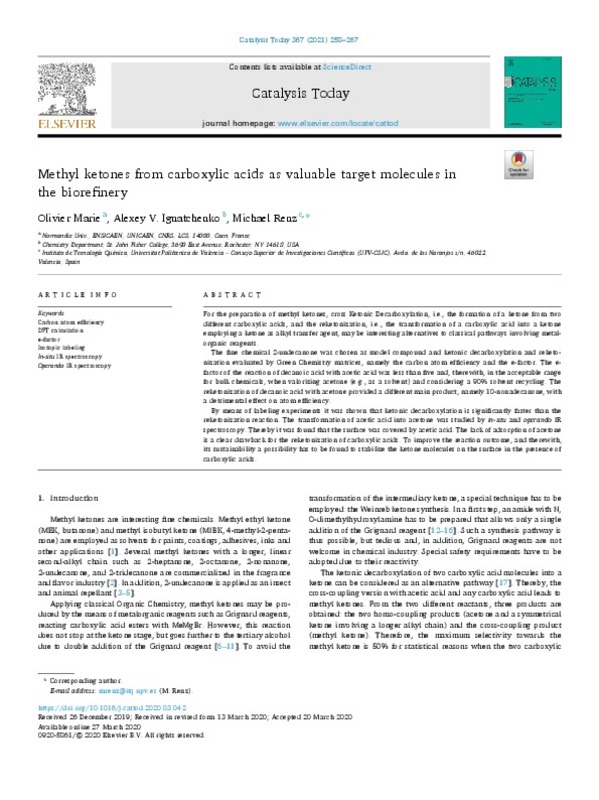JavaScript is disabled for your browser. Some features of this site may not work without it.
Buscar en RiuNet
Listar
Mi cuenta
Estadísticas
Ayuda RiuNet
Admin. UPV
Methyl ketones from carboxylic acids as valuable target molecules in the biorefinery
Mostrar el registro sencillo del ítem
Ficheros en el ítem
| dc.contributor.author | Marie, Olivier
|
es_ES |
| dc.contributor.author | Ignatchenko, Alexey, V.
|
es_ES |
| dc.contributor.author | Renz, Michael
|
es_ES |
| dc.date.accessioned | 2021-11-05T14:06:45Z | |
| dc.date.available | 2021-11-05T14:06:45Z | |
| dc.date.issued | 2021-05-01 | es_ES |
| dc.identifier.issn | 0920-5861 | es_ES |
| dc.identifier.uri | http://hdl.handle.net/10251/176256 | |
| dc.description.abstract | [EN] For the preparation of methyl ketones, cross Ketonic Decarboxylation, i.e., the formation of a ketone from two different carboxylic acids, and the reketonization, i.e., the transformation of a carboxylic acid into a ketone employing a ketone as alkyl transfer agent, may be interesting alternatives to classical pathways involving metalorganic reagents. The fine chemical 2-undecanone was chosen as model compound and ketonic decarboxylation and reketonization evaluated by Green Chemistry matrices, namely the carbon atom efficiency and the e-factor. The efactor of the reaction of decanoic acid with acetic acid was less than five and, therewith, in the acceptable range for bulk chemicals, when valorizing acetone (e.g., as a solvent) and considering a 90% solvent recycling. The reketonization of decanoic acid with acetone provided a different main product, namely 10-nonadecanone, with a detrimental effect on atom efficiency. By means of labeling experiments it was shown that ketonic decarboxylation is significantly faster than the reketonization reaction. The transformation of acetic acid into acetone was studied by in-situ and operando IR spectroscopy. Thereby it was found that the surface was covered by acetic acid. The lack of adsorption of acetone is a clear drawback for the reketonization of carboxylic acids. To improve the reaction outcome, and therewith, its sustainability a possibility has to be found to stabilize the ketone molecules on the surface in the presence of carboxylic acids. | es_ES |
| dc.description.sponsorship | Financial support from the Spanish Government is acknowledged (Ministry of Science, Innovation and Universities, RTC-2017-6087-5 and PGC2018-097277-B-I00). MR is grateful to the Generalitat Valenciana for a BEST-2015 fellowship and to Dilyana Mladenova, Arturo Valero Jim ' enez and Claudia Fern ' andez de la Pena for their contributions to the experimental work of the catalytic reactions. | es_ES |
| dc.language | Inglés | es_ES |
| dc.publisher | Elsevier | es_ES |
| dc.relation.ispartof | Catalysis Today | es_ES |
| dc.rights | Reconocimiento - No comercial - Sin obra derivada (by-nc-nd) | es_ES |
| dc.subject | Carbon atom efficiency | es_ES |
| dc.subject | DFT calculation | es_ES |
| dc.subject | E-factor | es_ES |
| dc.subject | Isotopic labeling | es_ES |
| dc.subject | In-situ IR spectroscopy | es_ES |
| dc.subject | Operando IR spectroscopy | es_ES |
| dc.subject.classification | QUIMICA INORGANICA | es_ES |
| dc.title | Methyl ketones from carboxylic acids as valuable target molecules in the biorefinery | es_ES |
| dc.type | Artículo | es_ES |
| dc.identifier.doi | 10.1016/j.cattod.2020.03.042 | es_ES |
| dc.relation.projectID | info:eu-repo/grantAgreement/AEI/Plan Estatal de Investigación Científica y Técnica y de Innovación 2017-2020/PGC2018-097277-B-I00/ES/MEJORA DEL CONCEPTO DE BIORREFINERIA MEDIANTE IMPLEMENTACION DE NUEVOS PROCESOS CATALITICOS CON CATALIZADORES SOLIDOS DE METALES NO NOBLES PARA LA PRODUCCION DE BIOCOMPUESTOS/ | es_ES |
| dc.relation.projectID | info:eu-repo/grantAgreement/AGENCIA ESTATAL DE INVESTIGACION//RTC-2017-6087-5-AR//TRANSFORMACIÓN TERMOQUÍMICA DE HYDROCHAR PARA PRODUCTOS DE ALTO VALOR, OPTIMIZACIÓN DE PRODUCTOS Y PROCESO EN UN REACTOR DE PARTÍCULAS/ | es_ES |
| dc.rights.accessRights | Abierto | es_ES |
| dc.description.bibliographicCitation | Marie, O.; Ignatchenko, AV.; Renz, M. (2021). Methyl ketones from carboxylic acids as valuable target molecules in the biorefinery. Catalysis Today. 367:258-267. https://doi.org/10.1016/j.cattod.2020.03.042 | es_ES |
| dc.description.accrualMethod | S | es_ES |
| dc.relation.publisherversion | https://doi.org/10.1016/j.cattod.2020.03.042 | es_ES |
| dc.description.upvformatpinicio | 258 | es_ES |
| dc.description.upvformatpfin | 267 | es_ES |
| dc.type.version | info:eu-repo/semantics/publishedVersion | es_ES |
| dc.description.volume | 367 | es_ES |
| dc.relation.pasarela | S\427395 | es_ES |
| dc.contributor.funder | AGENCIA ESTATAL DE INVESTIGACION | es_ES |






![[Cerrado]](/themes/UPV/images/candado.png)


